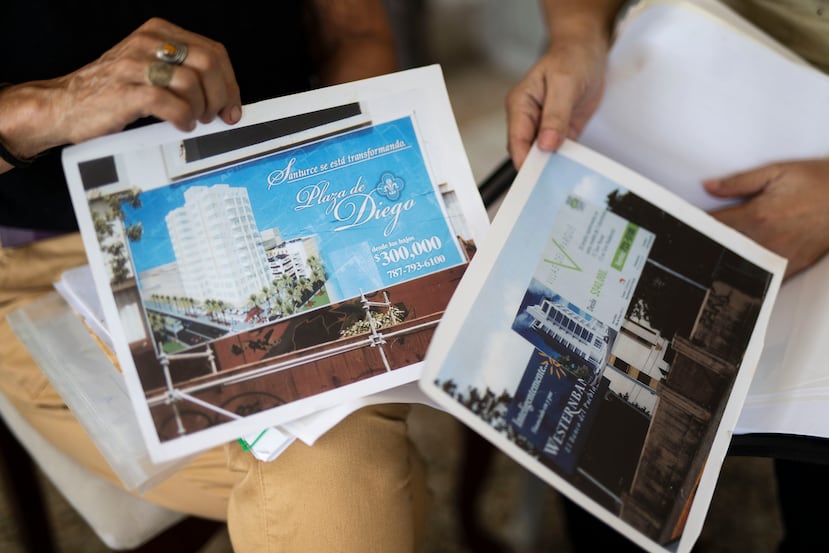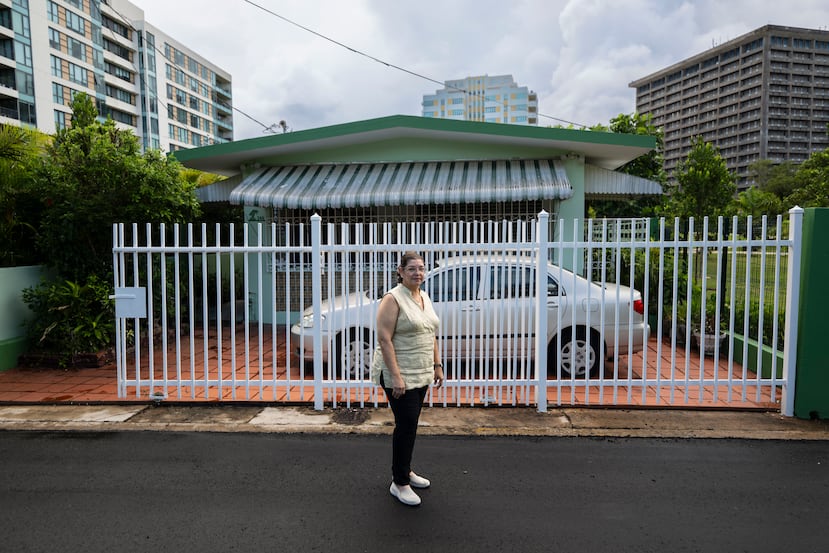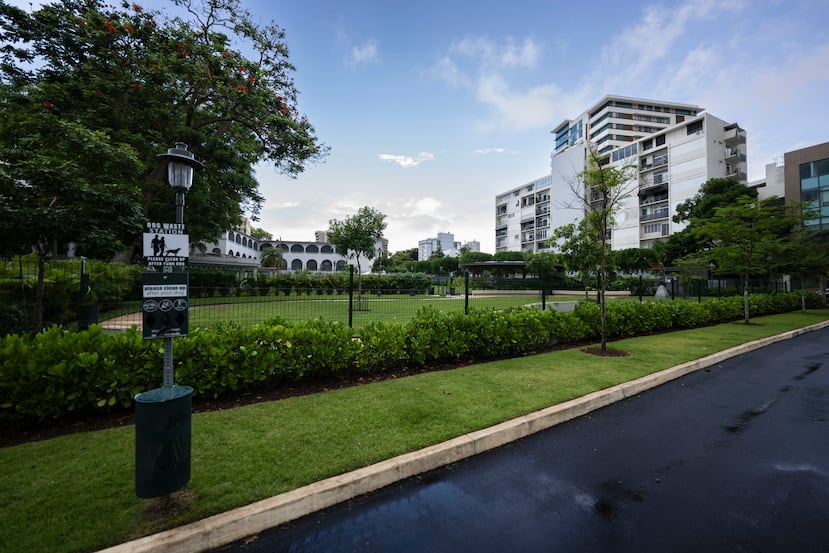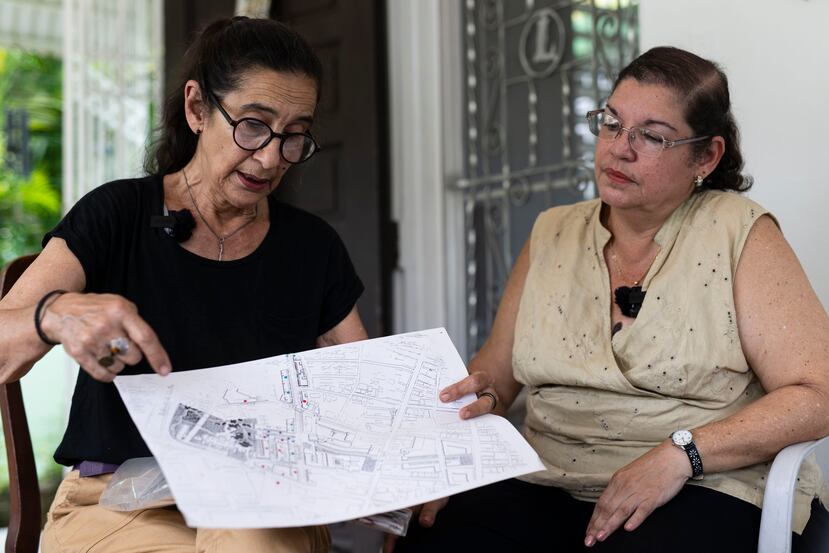The presence of a cement house -painted green and surrounded by plants- in the middle of the recently inaugurated Santurce Park, at first sight, may seem curious. Then, the story of the recent transformation of the area forces a reflection on what the property was in the past and, above all, how that singular earthen structure remains standing there.
---
Lee este artículo en español.
---
The only one who lives to answer these questions is Laura Lasanta Rivera, the last resident of Iglesias Street, whose family home is a testament to the struggle to remain that part of the community of San Mateo de Cangrejos, which was forcibly expropriated at the turn of the century to make way for new developments.
Remaining has also meant seeing the urban transformation of the Santurce area. But, for Laura, more than an evolution, it is about “a new community, with new people.”
“Most people don’t know what happened here. They think that this was always a barren lot, that there was nothing. That’s why they are surprised to see a ‘house inside the park,’ as they say,” said Lasanta Rivera, who added that she is happy to see older adults frequenting the park. That population, in fact, made up a large part of the former community.
Laura - a 65-year-old retired teacher - is intelligent and calm. Her eloquent speech remains virtually unchanged as she recounts the hard times she went through to stay there. Her routine, in this new community, includes walking through the green space that now surrounds her residence.
“I walk through the park but, when I am stepping on the areas, I know who they belonged to. So I walk in two steps,” she said, her voice breaking, referring to her former neighbors, with whom she had no further contact since 2005, when the last of the families left the community.
An unexpected visit in 2001
At the turn of the millennium, San Mateo de Cangrejos - a town founded by free black people in the 17th century - was a diverse community. It was home to families, workers, migrants, professionals and seniors, to name a few.
At that time, rumors of displacement were already circulating, fueled by cards in the mailboxes indicating interest in buying their homes. In 2001, Laura received a home visit on her way home from work at the Padre Rufo school. There, a worker from a company subcontracted by the Housing Department told her that she had “six months to leave her property” or she would be expropriated.
Laura called her neighbors and had the person come in, who told them, the woman said, about the plan to “rehabilitate Santurce” with “a huge blueprint of all the projects that were coming.” “And they were projects where - I started to realize - they were not counting on the people who were there,” she said.
Shortly thereafter, Mary Anne Hopgood Santaella joined the fight against the expropriations. Together with other organizations, she created the “Santurce no se vende” campaign, whose goal was to collect the stories of the people who resisted displacement, starting with a census. In addition, they organized protests, community meetings and even the Museo del Barrio, which collected and exhibited the objects left in the houses when the residents left.
“Santurce is people. This can’t be a structure.... This has to be a diverse, multiracial, multisectoral city. There has to be housing, shelter and quality of life for all people. It doesn’t matter what your social class is. That’s what this community had. It was one of the nicest communities you can imagine,” explains Hopgood Santaella about the message they were trying to convey.
In the interview with Lasanta Rivera, Hopgood Santaella, who has dedicated herself to documenting the process, explains that - in 2002 - Law 201 was passed that “empowered the Housing Department to expropriate for resale.” In 2003, the expropriation letters began to arrive.
“Most people don’t know what happened here. They think that this was always a barren lot, that there was nothing here. That’s why they are surprised to see a ‘house inside the park’, as they say ”
According to their calculations, the number of people displaced from this part of San Mateo is almost 440, in addition to dozens of expropriated businesses. The money given to the owners for their homes was not enough to buy a property nearby, and many migrated to other neighborhoods or municipalities, such as Aguas Buenas and San Sebastián. Few were able to stay in Santurce.
However, the development plans never materialized as originally conceptualized.

The family home
The four-bedroom, two-bath house that remains on Iglesias Street represents much more than a curious sight in the new park. For Laura, it is the legacy her father, Juan Lasanta, left for his offspring and the only opportunity he had to buy a home.
“My dad always said: ‘what I have to leave you are my last name, your studies and, now, at 65 years of age, this house for the two of you (Laura and her sister, Amárilys) for when your mom and I are not around,’” said the retired teacher, who also participated in the purchase of the home, since the transaction was not approved solely with her father’s salary.
When they bought the house, in 1995, they were informed that it was a construction of the engineer Iglesias, a relative of the soprano singer Olga Iglesias, to whose surname the street pays homage. The sturdy structure also served as a shelter for the victims of Hurricane Hugo in 1989.

This residence was also the place where -until last year- Laura took care of her sister, who was born with muscular dystrophy, and her mother, Juana Laura, who became catatonic in 2006, when she saw what was happening in her community and heard the noise of the machines demolishing her neighbors’ houses.
Laura does not forget the last words she heard her mother say: “‘I am afraid, the machines are coming. [...] Those were her last words. She grabbed my sister’s bed, crouched down and ‘disconnected’”.
“She ‘disconnected’ in denial of the threats, of the noise, when she saw in progress that the machines were already arriving (at Iglesias Street),” she explained.
How did she manage to survive?
Officially, the Lasanta Rivera family residence appears as expropriated since 2003, but Laura -because of her conviction to remain- never went to court to claim the money that the government deposited for her home.
The judicial proceedings of the expropriation were delayed for years: there were amendments to the lawsuit, hearings were increasingly sporadic and the Lasanta Rivera family even counterclaimed against the government. In this prolonged process, the PROMESA law and the bankruptcy of the government arrived, which caused a sort of “limbo” in which the case was paralyzed, said the resident.
Although technically the house is on state land, the property is now dedicated to a park for which the Putnam Bridge company has a 30-year management contract. This company was the one that finished developing the Ciudadela residential-commercial complex, as the original developers never completed the process.
The property, which had been vacant for years when it was leased by Nicholas Prouty’s company, was set aside as a green area because of the ecological and social benefits of such a space in an urban center like Santurce.

“Every big city deserves a good park. [The benefits of parks in residential areas is immense. On a community level, it’s a beneficial thing.] And, more than anything, it is to recognize that, in the train of life we lead on a daily basis, to pause to reflect, green areas, natural areas are essential. It’s nothing more than developing and developing, if there is no lifestyle,” said Joel Peña, Putnam Bridge’s chief operating officer.
“We have worked on this project, we have supported Laura because she lives there in her house. Why should we make life difficult for her? No, she is a person who needs to be assisted ”
When asked why they did not seek to remove Laura’s residence as part of the development, he responded that this was not a management that corresponded to them.
“What we have to recognize is that we have a person who has prevailed in her position and why we, a private entity, are going to mess with that. It does not correspond to us. We have worked on this project, we have supported Laura because she lives there in her house. Why are we going to make her life difficult? No, she is a person that we have to assist her in whatever we can do”, he stated.
Lasanta Rivera acknowledged that she has good communication with the administration of Ciudadela, since they are now her neighbors. Likewise, she highlighted that they asphalted the street, painted her home and pick up her garbage, since she said that the Municipality of San Juan did not do it.
“I’m glad they didn’t build what they (originally) wanted to build because it was going to be for a few specific people, not for everyone,” said Lasanta Rivera, who is still upset to talk about the expropriation process, but is comforted to know that at least the land was destined for a public purpose.
El Nuevo Día asked Peña if he would like the park to reflect the community that, for generations, lived in the space that is now a recreational area. He responded that he would like to engrave the names of the displaced families on the bricks at the entrance to the park “as an act of remembrance.”

For her part, Hopgood Santaella said she is glad that Laura is well, and that there is still a sign - the one on Iglesias Street - that says there was a community there.
Lasanta Rivera would like her legacy to be one of struggle. “We can’t continue to allow people or interests to come and say, ‘You have to leave because I want this,’ for no reason. The ‘you have to leave because you don’t fall into the prototype we want.’ That is unfair. So where are we going to end up, in the Atlantic and in the Caribbean, if they keep pushing?”
---
This content was translated from Spanish to English using artificial intelligence and was reviewed by an editor before being published.


